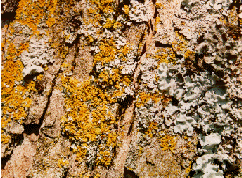
Lichens
Index
Archive
Resources
Global Lab
What Are Lichens?

A lichen is an associated organism: two very different beings, an alga and a fungus, live together in a qualified symbiotic association, producing a new body, or lichen thallus. Much of the lichen body is a tangle of fungal filaments called hyphae; these filaments clasp alga, sometimes in a mat, or sometimes wrapped as single cells. The fungus collects water and provides structure and protection for the alga, and may in certain species extract minerals for both organisms from the substrate. The alga possesses chloroplasts and can photosynthesize, thus providing carbohydrates for both itself and its fungal partner.
When a fungus joins with an alga, it is said to be "lichenized." Many scientists, consulting a family tree of DNA, now believe that different forms of lichens evolved in independent strands of fungi development. They do not agree on the number of strands.
Lichens have special adaptations which permit them to withstand extremes of moisture and temperature. When moisture is available, it is taken up by the fungus leading to a mechanical change which allows more light to get through, triggering algal photosynthesis; new food and new tissue are then made. When the atmosphere is dry, however, the lichen is dormant and does not grow.
Because lichens are hardy, love light, live a long time, and grow slowly, they can be pioneers in many inhospitable environments such as tundra, exposed rock surfaces, asbestos, mortar, tropical leaf surfaces, and even in water. When they decay, their nutrients nourish new settlers such as moss.
Back to Lichens Index
Contact: Global Lab
� 1997 TERC. All rights reserved.